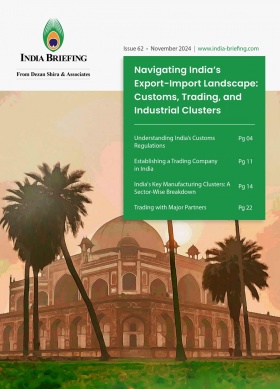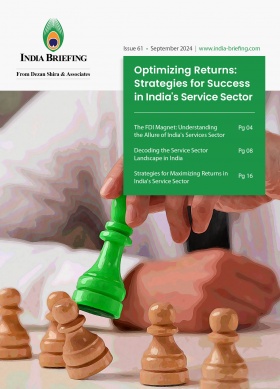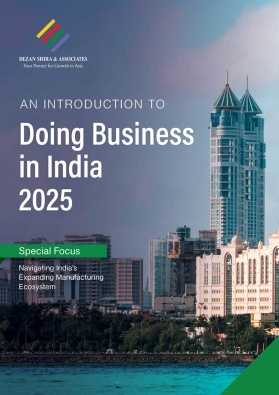India’s Union Budget 2025-26 Highlights: Reforms to Drive Economic Growth, Manufacturing, Consumption
India’s Finance Minister, Nirmala Sitharaman, presented the Union Budget for 2025-26 on February 1 in Parliament. The budget introduces significant reforms, including the removal of income tax liability (under the new regime) for individuals earning up to INR 1.2 million annually, excluding special income. Additionally, the budget outlines reforms aimed at supporting startups and MSMEs, alongside a focus on key sectors for manufacturing growth. For questions on how this budget could impact your business and investments in India, reach our experts at India@dezshira.com.
India’s Union Budget 2025-26 reaffirms the government’s commitment to fostering economic growth, strengthening financial resilience, and creating an inclusive development landscape. With a strong focus on boosting private sector investments, empowering MSMEs, and advancing infrastructure development, the upcoming fiscal year’s budget introduces transformative reforms across taxation, financial regulation, agriculture, exports, and urban development. Prime Minister Narendra Modi’s government remains focused on the broader goal of positioning India as a global economic powerhouse.
Fiscal strategy
On fiscal consolidation, the Revised Estimate 2024-25 fiscal deficit is at 4.8 percent of GDP, with Budget Estimates for 2025-26 set at 4.4 percent of GDP. Government receipts (excluding borrowings) for 2025-26 are projected at INR 34.96 trillion, with total expenditure at INR 50.65 trillion.
|
Fiscal Indicator |
FY 2024-25 Revised Estimate (RE) |
FY 2025-26 Budget Estimate (BE) |
|
GDP size (at current prices) |
INR 324.11 trillion |
|
|
Fiscal deficit |
4.8% |
4.4% |
|
Total receipts excluding borrowings |
INR 31.47 trillion |
INR 34.96 trillion |
|
Net tax receipts |
INR 25.57 trillion |
INR 28.37 trillion |
|
Capital expenditure |
INR 10.18 trillion |
INR 11.2 trillion |
|
Total expenditure |
INR 47.16 trillion |
INR 50.65 trillion |
|
Gross market borrowing |
INR 12.44 trillion |
INR 14.82 trillion |
Key growth drivers: Agriculture, MSMEs, investment, and exports
The Budget identifies four key pillars to drive the nation’s economic momentum—agriculture, MSMEs, investment, and exports. These sectors will act as growth engines, fueled by targeted reforms and strategic government interventions.
1. Agriculture: Empowering farmers and achieving rural development
Recognizing agriculture as the backbone of the Indian economy, the government has introduced the ‘Prime Minister Dhan-Dhaanya Krishi Yojana’, covering 100 districts to enhance productivity, crop diversification, post-harvest storage, and irrigation infrastructure. Additionally, a six-year “Mission for Aatmanirbharta in Pulses” will focus on self-sufficiency in Tur, Urad, and Masoor, ensuring procurement support through central agencies like NAFED and NCCF.
To address rural underemployment, the government will launch a comprehensive ‘Rural Prosperity and Resilience’ program, integrating skill development, investment, and technology to generate sustainable rural employment opportunities, with a particular focus on rural women and small-scale farmers. The loan limit for Kisan Credit Cards has been increased from INR 300,000 to INR 500,000, providing greater financial security to farmers.
2. MSMEs: Strengthening small businesses for global competitiveness
MSMEs contribute nearly 45 percent to India’s exports, making them a vital component of economic growth. The Budget has enhanced investment and turnover limits for MSME classification to 2.5 and 2 times, respectively, facilitating greater access to capital and technology.
A new scheme targeting 500,000 first-time entrepreneurs from Scheduled Castes, Scheduled Tribes, and women will provide term loans of up to INR 20 million over the next 5 years. Additionally, the National Manufacturing Mission will drive the ‘Make in India’ initiative by integrating small, medium, and large industries into the global value chain, with a special focus on making India a global hub for toy manufacturing. The mission also has a mandate to focus on clean tech manufacturing for climate-friendly development and facilitating a future-ready workforce for in-demand jobs.
|
Revised Classification Criteria for MSMEs Proposed Under Budget 2025-26 |
||||
|
Entity size |
Investment |
Turnover |
||
|
|
Current |
Revised |
Current |
Revised |
|
Micro enterprises |
INR 10 million |
INR 25 million |
INR 50 million |
INR 100 million |
|
Small enterprises |
INR 100 million |
INR 250 million |
INR 500 million |
INR 1 billion |
|
Medium enterprises |
INR 500 million |
INR 1.25 billion |
INR 2.5 billion |
INR 5 billion |
3. Investment: Infrastructure, innovation, and skilling
Investment remains a central theme in the Budget, categorized into three key areas—people, economy, and innovation.
- Investment in people:
- Establishment of 50,000 Atal Tinkering Labs in government schools.
- Broadband connectivity for all government secondary schools and primary health centers in rural areas under the BharatNet project.
- Five National Centers of Excellence for Skilling with global expertise to equip youth for manufacturing and technology sectors.
- A INR 5 billion Centre of Excellence in Artificial Intelligence for education.
- A structured initiative to provide Gig workers with identity cards, healthcare coverage under PM Jan Arogya Yojana, and their registration on the e-Shram portal.
- Investment in the economy:
- Infrastructure ministries will roll out a 3-year PPP project pipeline.
- INR 1.5 trillion interest-free loans to states for capital expenditure.
- The second Asset Monetization Plan (2025-30) aims to reinvest INR 10 trillion into new projects.
- Urban Challenge Fund of INR 1 trillion for urban redevelopment and water sanitation projects.
- Investment in innovation:
- INR 200 billion allocated to private sector-driven R&D initiatives.
- National Geospatial Mission to support urban planning.
- Gyan Bharatam Mission to survey, document, and conserve over 10 million manuscripts, alongside a National Digital Repository of Indian knowledge systems.
4. Exports: Enhancing global trade capabilities
A dedicated Export Promotion Mission, spearheaded by the Ministries of Commerce, MSME, and Finance, aims to integrate MSMEs into global supply chains. The ‘BharatTradeNet’ (BTN) digital platform will streamline trade documentation and financing solutions, improving ease of doing business.
The Budget also focuses on bolstering domestic manufacturing capacities to align with global supply chain demands. Key initiatives include:
- Infrastructure and warehousing enhancements for air cargo, particularly for high-value perishable horticulture produce.
- Support for domestic electronic equipment industries to capitalize on Industry 4.0.
- A National Framework for Global Capability Centers (GCCs) to boost services from emerging Tier 2 cities.
Financial sector reforms and investment climate
To sustain economic acceleration, the government is prioritizing regulatory and financial sector reforms to simplify compliance, expand services, and promote investment.
- FDI reforms: The Foreign Direct Investment (FDI) limit for insurance companies will increase from 74 percent to 100 percent, conditional on full premium investment within India.
- Regulatory overhaul:
- High-level committee for regulatory reforms will review non-financial sector regulations, licenses, and compliance measures.
- Investment friendliness index of states to foster competitive cooperative federalism.
- Financial Stability and Development Council (FSDC) to evaluate financial regulations and enhance responsiveness.
- Jan Vishwas Bill 2.0 to decriminalize over 100 legal provisions, furthering ease of doing business.
Taxation reforms: Measures impacting direct tax, indirect tax, crypto assets, international tax, and transaction tax
Relief for India’s middle class and low-income earners
The Budget proposes a structured direct tax reform, offering significant relief to the middle class. The revised tax structure under the New Tax Regime includes:
|
Proposed Revisions to India’s New Tax Regime |
|
|
Total income per annum |
Rate of tax |
|
INR 0 – 400,000 |
NIL |
|
INR 400,000 – 800,000 |
5% |
|
INR 800,000 – 1.2 million |
10% |
|
INR 1.2 – 1.6 million |
15% |
|
INR 1.6 – 2 million |
20% |
|
INR 2.0 – 2.4 million |
25% |
|
Above INR 2.4 million |
30% |
Per tax experts, this means that a salaried individual—opting for the new tax regime—with a total income of up to INR 1.275 million will be exempt from tax due to the increase in the tax rebate from INR 25,000 to INR 60,000.
Additional tax relief measures
- Increased TDS (Tax Deducted at Source) threshold on interest earned by senior citizens from INR 50,000 to INR 100,000. For other resident individuals, the limit for TDS has been increased to INR 50,000 from the current INR 40,000. For mutual fund investments, the TDS threshold on dividends is increased to INR 10,000 from INR 5,000.
- TDS threshold on rent has been raised to INR 600,000 from INR 240,000.
- Time-limit extension for filing an updated tax return from 3-5 years, effective April 1, 2025. If filed after three years but within four years, an additional 60 percent tax will be payable, increasing to 70 percent if filed after 4 years but within 5 years.
- The filing of updated tax returns will be disallowed if a reassessment notice is issued after 4 years, unless the reassessment is subsequently dropped.
- Additionally, purchases made in India by non-residents for export will not constitute a significant economic presence from FY 2025-26 onwards.
- Proposal to extend the tonnage tax scheme to inland vessels registered under the Indian Vessels Act, 2021, to promote inland water transport from FY 2025-26.
- The deadline for the incorporation of eligible start-ups to avail of the 3-year tax holiday within their first 10 years has been extended from March 31, 2025, to March 31, 2030.
- The last date for investment by Sovereign Wealth Funds and Pension Funds to qualify for tax exemptions has been extended from March 31, 2025, to March 31, 2030.
- The threshold for Tax Collected at Source (TCS) on remittances under the Liberalized Remittance Scheme (LRS) extended to INR 1 million per financial year from the existing INR 700,000 per financial year. This revision impacts individuals sending money abroad for travel, education, and other expenses. It is also proposed that TCS be removed on remittances for education purposes, “where such remittance is out of a loan taken from a specified financial institution”.
New income tax bill 2025
A new Income Tax Bill (Bill 2025) is set to be introduced in Parliament next week. The bill is designed to be clear and concise, reducing the length of the existing law by nearly half. Its simplified structure aims to enhance tax certainty and minimize litigation.
Compliance for crypto investors
Starting April 1, 2026, a new annual reporting requirement for crypto assets will be introduced, outlining specific rules for reporting entities, information scope, reporting methods, and due diligence procedures. Additionally, from FY 2025-26, the definition of virtual digital assets (VDA) will be expanded to include any crypto asset utilizing cryptographic and distributed ledger technology for transaction validation and security.
International tax
Effective April 1, 2026 (FY 2025-26), a new presumptive taxation regime is proposed for non-residents providing services or technology for setting up an electronics manufacturing facility in India. Under this proposal, 25 percent of the total amount received or due to be received by a non-resident will be deemed as profits or gains, resulting in an effective tax rate of less than 10 percent on gross receipts.
Additionally, the provision for Significant Economic Presence (SEP) has been harmonized with business connection rules. Non-residents engaged in purchasing goods in India for export will no longer be subject to SEP regulations.
Notably, there are no specific proposals regarding the implementation of Pillar Two or the Global Minimum Tax in India.
Mergers and capital gains
The procedure for the expedited approval of company mergers will be streamlined, with the process for fast-track mergers expanded and simplified.
- Losses incurred by a predecessor entity due to amalgamation or business reorganization can be carried forward and set off for up to 8 years after the assessment year in which the loss was first calculated.
- The long-term capital gains (LTCG) tax on business trusts (Real Estate Investment Trusts and Infrastructure Investment Trusts) will be reduced to 12.5 percent (plus applicable surcharge and cess) and will not be taxed at the highest marginal rate.
- LTCG tax on the transfer of certain securities by Foreign Institutional Investors (FIIs) will be adjusted from 10 percent to 12.5 percent (plus applicable surcharge and cess).
- Securities held by Category-I and Category-II Alternative Investment Funds (AIFs) will be classified as ‘capital assets,’ and the income generated from them will be treated as capital gains.
Transfer pricing
The introduction of “Block Assessments” for transfer pricing (TP) proposes a shift from the current practice where TP audits are conducted separately for each financial year (FY). Instead, TP assessments or audits would cover a block of three consecutive FYs, reducing both the compliance burden on taxpayers and the administrative workload on Transfer Pricing Officers (TPOs) when transactions are identical or similar.
Taxpayers would have the option to elect block assessments when referred for a TP audit for a specific FY. However, this option will not be available in cases involving search and seizure operations.
Taxpayers would need to exercise this option within the prescribed time frame and format, and the TPO would verify the validity of the taxpayer’s election based on certain conditions. If the option is deemed valid, the arm’s length price (ALP) determined for the selected FY would apply to the two subsequent FYs for similar transactions. The Assessing Officer (AO) would then recompute the total income for all three FYs based on the ALP determined by the TPO and the Dispute Resolution Panel. This adjustment must be completed within 3 months after the audit or assessment is concluded.
Additionally, the Central Board of Direct Taxes (CBDT) may issue clarifying guidelines, which would be subject to Parliamentary approval and would be binding on both taxpayers and tax authorities. This amendment is scheduled to take effect from April 1, 2026 (FY 2025-26).
The 2025-26 Budget Speech has also proposed an expansion of the Safe Harbor Rules to reduce litigation and provide greater certainty.
Goods and services tax
Under the Goods and Services Tax (GST) framework, several key changes have been proposed. The term “plant or machinery” in Section 17(5)(d) of the CGST Act 2017 has been retrospectively replaced with “plant and machinery.”
Additionally, the supply of goods warehoused in Special Economic Zones (SEZs) or Free Trade and Warehousing Zones (FTWZs) to any person, before clearance for exports or to the Domestic Tariff Area (DTA), will be treated as neither a supply of goods nor a supply of services, also retrospectively.
Provisions regarding the time of supply for vouchers will be omitted, with a focus on ensuring that GST is not levied on vouchers.
Furthermore, a reduction in liability for credit notes will not be allowed unless the Input Tax Credit (ITC) has been reversed by the recipient or the tax incidence has been passed on to another person.
Lastly, a pre-deposit of 10 percent of the penalty amount is now required when filing an appeal before the First Appellate Authority and the GST Appellate Tribunal, provided the order concerns only the penalty.
Customs: Duty rate revisions and rationalization
Customs duty rates have been rationalized to support domestic manufacturing and value addition, promote exports, and facilitate trade. An interim board will be established to handle functions related to case settlements. Clear timelines have been set for the finalization of provisional assessments. Additionally, a new mechanism will be introduced to allow importers and exporters to voluntarily revise any entry post-clearance of goods within a prescribed timeframe.
Rationalization of customs tariff structure for industrial goods at a glance
- Removal of seven tariff rates.
- Limitation to a maximum of one cess or surcharge per item.
- Application of an equivalent cess to maintain the effective duty incidence on most items, with a lower cess applied to certain items.
Sector-specific proposals
- Make in India: Exemption granted for the import of open cells for LED/LCD TVs, looms for textiles, and capital goods for lithium-ion batteries used in mobile phones and electric vehicles (EVs).
- Promotion of MRO (maintenance, repair, and overhaul): A 10-year exemption for goods used in shipbuilding and shipbreaking; extended time limits for the export of railway goods imported for repairs.
- Export promotion: Duty-free inputs for the handicraft and leather sectors.
- Trade facilitation:
- Fixed time limits for the finalization of provisional assessments.
- Introduction of a provision allowing voluntary declarations of material facts post-clearance, with duty payment and interest, but without penalties.
- IGCR Rules amended to extend the time limit to one year and allow for the filing of quarterly statements instead of monthly.
- Improved access to life-saving medicines: For rare diseases, cancer, and severe chronic diseases, 36 life-saving drugs/medicines have been added to the duty-exempt list, with six medicines included in the 5 percent duty list. Additionally, 37 medicines and 13 new patient assistance programs have been added to the exempt list.
Conclusion: A strategic budget for a resilient economy
The Union Budget 2025-26 has sought to deliver a balanced approach to economic expansion, fiscal prudence, and social inclusivity. By prioritizing investment, innovation, regulatory reforms, and tax rationalization, the government is hoping to achieve sustainable and broad-based economic growth – in particular, resuscitate consumption and incentivize private sector business activity.
About Us
India Briefing is one of five regional publications under the Asia Briefing brand. It is supported by Dezan Shira & Associates, a pan-Asia, multi-disciplinary professional services firm that assists foreign investors throughout Asia, including through offices in Delhi, Mumbai, and Bengaluru in India. Readers may write to india@dezshira.com for support on doing business in India. For a complimentary subscription to India Briefing’s content products, please click here.
Dezan Shira & Associates also maintains offices or has alliance partners assisting foreign investors in China, Hong Kong SAR, Dubai (UAE), Indonesia, Singapore, Vietnam, Philippines, Malaysia, Thailand, Bangladesh, Italy, Germany, the United States, and Australia.
- Previous Article Economic Survey of India 2024-25: Key Highlights
- Next Article India’s POSH Act: Annual Reporting Obligations and Proposed Amendments








